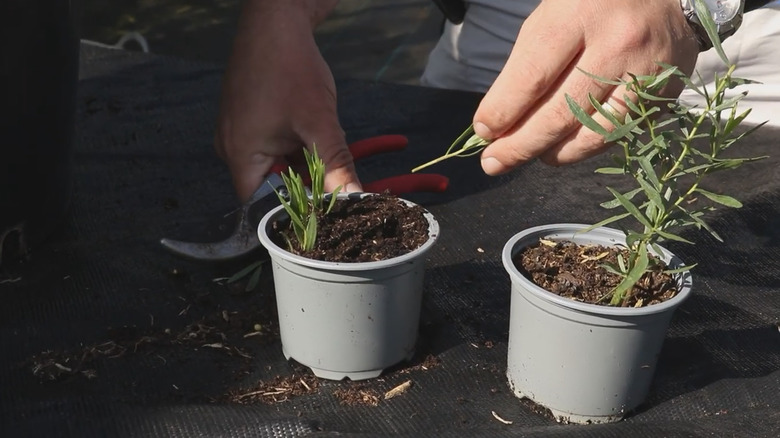The Herb You Can Propagate In Winter And Plant By Spring
Herb gardens have been a key part of human development, whether it be a means of seasoning food, developing scents, or repelling insects. Luckily, most herbs will grow perfectly well in a container, which means you can propagate them indoors or outdoors, and move them back-and-forth. French tarragon (Artemisia dracunculus) — particularly the sativa cultivar that's commonly referred to as "chef's herb" — is a must-have variety for your kitchen. This herb is great as a source of calcium, potassium, and vitamin A, but dried, preserved leaves will lose a lot of their flavor. Bringing plants indoors and propagating new growths over the winter offers more opportunities to use the fresh stuff, and propagating these plants will help you get a jump on your spring landscaping.
French tarragon will thrive in USDA hardiness zones 3 through 8, which puts it at home across most of the continental U.S. (besides warmer pockets of California and Florida). It is a tender, winter-dormant perennial that does not produce flowers. Tarragon seeds you find on the market will generally not grow the French variety, but instead the less-flavorful Russian tarragon. The herb should instead be propagated via division, root cutting, or stem cutting. The best time to take 6-inch cuttings is around late spring or summer, using a knife for brittle roots. However, while you can overwinter your French tarragon by shearing them to ground level after your last fall harvest, this is also a perfect time to bring the plant indoors so you can propagate more.
French tarragon can be propagated indoors over winter
If you're starting your journey with propagating French tarragon during the winter, any pot you use should have well-drained loamy soil (a sandier texture will be better) and the cutting should be watered regularly until it's established. Unless you're dividing a whole plant, the tips of the shoots are going to be the best places to take cuttings, and dipping the ends in root growth hormones will help most herbs along. You should push the tarragon cuttings gently into the soil after removing of few of their lower leaves. After your tarragon has taken root, it will appreciate soil that completely dries out; French tarragon is a drought-resistant herb that prefers to not constantly be wet. Using heating systems during the winter will dry out the air in your home, which is actually good for a propagule that doesn't want to always be moist.
Another important thing to keep in mind when it comes to growing this herb during winter is that French tarragon prefers 6 hours of full sunlight. It's going to be tricky to get perfect lighting indoors unless you have large windows, and that doesn't even account for the fact that some areas of the U.S. will see sunsets as early as 4:00 p.m. during winter. There are ways for you to help indoor plants thrive during the winter despite the cold and lack of sunlight, but you should not use a lot of fertilizer, as this can take away from the flavor of the herb. To mimic natural sunlight, keep propagated herbs like French tarragon about 1 foot away from cool, white fluorescent grow lights (around 40 watts) for around 14 hours a day.
Moving your winter-propagated French tarragon outdoors in spring
While propagating French tarragon indoors, it's worth knowing that the herb is poisonous to animals including cats, dogs, and horses. These symptoms range in severity from vomiting and diarrhea to comas. French tarragon is also susceptible to problems with root rot and mildew if overwatered, and its leaves tend to bruise easily. Meanwhile, if the leaves begin to turn yellow and brown, these should be removed at risk of fungal infections. With all that being said, it's an herb that keeps on giving if you decide to transplant it during the spring.
Indoor plants should be moved outside after nighttime temperatures are consistently above 50 degrees Fahrenheit, likely around May (though this will vary based on your local environment). Mulching the herbs, perhaps by laying grass clippings over their roots, can help keep them warm during colder months. French tarragon should be spaced approximately 2 feet apart if transplanted into a spring herb garden, or French tarragon can be a strong companion plant to crops like eggplant if you want to space it amid your vegetables. If you've been using technological aids like grow lights over the winter, it's important to acclimate them to harsher sunlight. Leaf burn or discoloration can happen if you move indoor-propagated tarragon into direct sun too quickly. After the herb is established outdoors, you'll want to divide it every two or three years to ensure it doesn't lose its vigor, and this will give you the opportunity to propagate new growths all over again.


